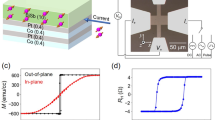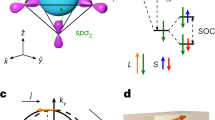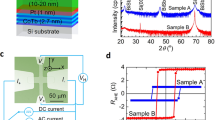Abstract
The spin–orbit torque (SOT) that arises from materials with large spin–orbit coupling promises a path for ultralow power and fast magnetic-based storage and computational devices. We investigated the SOT from magnetron-sputtered BixSe(1–x) thin films in BixSe(1–x)/Co20Fe60B20 heterostructures by using d.c. planar Hall and spin-torque ferromagnetic resonance (ST-FMR) methods. Remarkably, the spin torque efficiency (θS) was determined to be as large as 18.62 ± 0.13 and 8.67 ± 1.08 using the d.c. planar Hall and ST-FMR methods, respectively. Moreover, switching of the perpendicular CoFeB multilayers using the SOT from the BixSe(1–x) was observed at room temperature with a low critical magnetization switching current density of 4.3 × 105 A cm–2. Quantum transport simulations using a realistic sp3 tight-binding model suggests that the high SOT in sputtered BixSe(1–x) is due to the quantum confinement effect with a charge-to-spin conversion efficiency that enhances with reduced size and dimensionality. The demonstrated θS, ease of growth of the films on a silicon substrate and successful growth and switching of perpendicular CoFeB multilayers on BixSe(1–x) films provide an avenue for the use of BixSe(1–x) as a spin density generator in SOT-based memory and logic devices.
This is a preview of subscription content, access via your institution
Access options
Access Nature and 54 other Nature Portfolio journals
Get Nature+, our best-value online-access subscription
$29.99 / 30 days
cancel any time
Subscribe to this journal
Receive 12 print issues and online access
$259.00 per year
only $21.58 per issue
Buy this article
- Purchase on Springer Link
- Instant access to full article PDF
Prices may be subject to local taxes which are calculated during checkout




Similar content being viewed by others
References
Hasan, M. Z. & Kane, C. L. Colloquium: topological insulators. Rev. Mod. Phys. 82, 3045–3067 (2010).
Zhang, H. et al. Topological insulators in Bi2Se3, Bi2Te3 and Sb2Te3 with a single Dirac cone on the surface. Nat. Phys. 5, 438–442 (2009).
Mellnik, A. R. et al. Spin-transfer torque generated by a topological insulator. Nature 511, 449–451 (2014).
Fan, Y. et al. Magnetization switching through giant spin–orbit torque in a magnetically doped topological insulator heterostructure. Nat. Mater. 13, 699–704 (2014).
Kondou, K. et al. Fermi-level-dependent charge-to-spin current conversion by Dirac surface states of topological insulators. Nat. Phys. 12, 1027–1032 (2016).
Wang, Y. et al. Topological surface states originated spin–orbit torques in Bi2Se3. Phys. Rev. Lett. 114, 257202 (2015).
Li, C. H. et al. Electrical detection of charge-current-induced spin polarization due to spin-momentum locking in Bi2Se3. Nat. Nanotech 9, 218–224 (2014).
Ando, Y. et al. Electrical detection of the spin polarization due to charge flow in the surface state of the topological insulator Bi1.5Sb0.5Te1.7Se1.3. Nano Lett. 14, 6226–6230 (2014).
Chen, Y. L. et al. Experimental realization of a three-dimensional topological insulator, Bi2Te3. Science 325, 178–180 (2009).
Pan, Z.-H. et al. Electronic structure of the topological insulator Bi2Se3 using angle-resolved photoemission spectroscopy: evidence for a nearly full surface spin polarization. Phys. Rev. Lett. 106, 257004 (2011).
Manchon, A. et al. Current-induced spin–orbit torques in ferromagnetic and antiferromagnetic systems. Preprint at http://arXiv.org/cond-mat.mes-hall/1801.09636 (2018).
Jamali, M. et al. Giant spin pumping and inverse spin Hall effect in the presence of surface and bulk spin-orbit coupling of topological insulator Bi2Se3. Nano Lett. 15, 7126–7132 (2015).
Shiomi, Y. et al. Spin–electricity conversion induced by spin injection into topological insulators. Phys. Rev. Lett. 113, 196601 (2014).
Deorani, P. et al. Observation of inverse spin Hall effect in bismuth selenide. Phys. Rev. B 90, 94403 (2014).
Rojas-Sánchez, J.-C. et al. Spin to charge conversion at room temperature by spin pumping into a new type of topological insulator: α-Sn films. Phys. Rev. Lett. 116, 96602 (2016).
Liu, L. et al. Spin-torque switching with the giant spin Hall effect of tantalum. Science 336, 555–558 (2012).
Manchon, A. & Zhang, S. Theory of spin torque due to spin-orbit coupling. Phys. Rev. B 79, 94422 (2009).
Suzuki, T. et al. Current-induced effective field in perpendicularly magnetized Ta/CoFeB/MgO wire. Appl. Phys. Lett. 98, 142505 (2011).
Miron, I. M. et al. Perpendicular switching of a single ferromagnetic layer induced by in-plane current injection. Nature 476, 189–193 (2011).
Manchon, A., Koo, H. C., Nitta, J., Frolov, S. M. & Duine, R. A. New perspectives for Rashba spin–orbit coupling. Nat. Mater. 14, 871–882 (2015).
Slonczewski, J. C. Current-driven excitation of magnetic multilayers. J. Magn. Magn. Mater. 159, L1–L7 (1996).
Chappert, C., Fert, A. & Van Dau, F. N. The emergence of spin electronics in data storage. Nat. Mater. 6, 813–823 (2007).
Brataas, A. & Hals, K. M. D. Spin–orbit torques in action. Nat. Nanotechnol. 9, 86–88 (2014).
Pai, C. F. et al. Spin transfer torque devices utilizing the giant spin Hall effect of tungsten. Appl. Phys. Lett. 101, 122404 (2012).
Manipatruni, S., Nikonov, D. E. & Young, I. A. Energy-delay performance of giant spin Hall effect switching for dense magnetic memory. Appl. Phys. Express 7, 103001 (2014).
Kim, J. et al. Layer thickness dependence of the current-induced effective field vector in Ta|CoFeB|MgO. Nat. Mater. 12, 240–245 (2013).
Zhao, Z., Jamali, M., Smith, A. K. & Wang, J. P. Spin Hall switching of the magnetization in Ta/TbFeCo structures with bulk perpendicular anisotropy. Appl. Phys. Lett. 106, 132404 (2015).
Hao, Q. & Xiao, G. Giant spin Hall effect and switching induced by spin-transfer torque in a W/Co40Fe40B20/MgO structure with perpendicular magnetic anisotropy. Phys. Rev. Appl. 3, 34009 (2015).
Liu, L., Lee, O. J., Gudmundsen, T. J., Ralph, D. C. & Buhrman, R. A. Current-induced switching of perpendicularly magnetized magnetic layers using spin torque from the spin Hall effect. Phys. Rev. Lett. 109, 96602 (2012).
Han, J. et al. Room-temperature spin–orbit torque switching induced by a topological insulator. Phys. Rev. Lett. 119, 77702 (2017).
Wang, Y. et al. Room temperature magnetization switching in topological insulator–ferromagnet heterostructures by spin–orbit torques. Nat. Commun. 8, 1364 (2017).
Kawaguchi, M. et al. Current-induced effective fields detected by magnetotransport measurements. Appl. Phys. Express 6, 113002 (2013).
Liu, L., Moriyama, T., Ralph, D. C. & Buhrman, R. A. Spin-torque ferromagnetic resonance induced by the spin Hall effect. Phys. Rev. Lett. 106, 36601 (2011).
Xu, W. J. et al. Scaling law of anomalous Hall effect in Fe/Cu bilayers. Eur. Phys. J. B 65, 233–237 (2008).
Şahin, C. & Flatte, M. E. Tunable giant spin Hall conductivities in a strong spin–orbit semimetal: Bi1–xSbx. Phys. Rev. Lett. 114, 107201 (2015).
Zhang, W., Han, W., Jiang, X., Yang, S.-H. & Parkin, S. S. P. Role of transparency of platinum–ferromagnet interfaces in determining the intrinsic magnitude of the spin Hall effect. Nat. Phys. 11, 496–503 (2015).
Ashcroft, N. W. & Mermin, N. D. Solid State Physics (Brooks-Cole, Grove, 1976).
Kobayashi, K. Electron transmission through atomic steps of Bi2Se3 and Bi2Te3 surfaces. Phys. Rev. B 84, 205424 (2011).
Edelstein, V. M. Spin polarization of conduction electrons induced by electric current in two-dimensional asymmetric electron systems. Solid State Commun. 73, 233–235 (1990).
Ndiaye, P. B. et al. Dirac spin–orbit torques and charge pumping at the surface of topological insulators. Phys. Rev. B 96, 14408 (2017).
Ghosh, S. & Manchon, A. Spin–orbit torque in a three-dimensional topological insulator–ferromagnet heterostructure: crossover between bulk and surface transport. Phys. Rev. B 97, 134402 (2018).
Fischer, M. H., Vaezi, A., Manchon, A. & Kim, E.-A. Spin-torque generation in topological insulator based heterostructures. Phys. Rev. B 93, 125303 (2016).
Mahfouzi, F., Nikoli, B. K. & Kioussis, N. Antidamping spin–orbit torque driven by spin–flip reflection mechanism on the surface of a topological insulator: a time-dependent nonequilibrium Green function approach. Phys. Rev. B 93, 115419 (2016).
Kurebayashi, H. et al. An antidamping spin-orbit torque originating from the Berry curvature. Nat. Nanotech 9, 211–217 (2014).
Bahramy, M. S. et al. Emergent quantum confinement at topological insulator surfaces. Nat. Commun. 3, 1159 (2012).
Avci, C. O. et al. Interplay of spin–orbit torque and thermoelectric effects in ferromagnet/normal-metal bilayers. Phys. Rev. B 90, 224427 (2014).
Pai, C.-F., Mann, M., Tan, A. J. & Beach, G. S. D. Determination of spin torque efficiencies in heterostructures with perpendicular magnetic anisotropy. Phys. Rev. B 93, 144409 (2016).
Cao, J. et al. Spin–orbit torques induced magnetization reversal through asymmetric domain wall propagation in Ta/CoFeB/MgO structures. Sci. Rep. 8, 1355 (2018).
Rojas-Sánchez, J.-C. et al. Spin pumping and inverse spin Hall effect in platinum: the essential role of spin-memory loss at metallic interfaces. Phys. Rev. Lett. 112, 106602 (2014).
Avci, C. O. et al. Current-induced switching in a magnetic insulator. Nat. Mater. 16, 309–314 (2016).
Li, P. et al. Spin–orbit torque-assisted switching in magnetic insulator thin films with perpendicular magnetic anisotropy. Nat. Commun. 7, 12688 (2016).
Agarwala, A. & Shenoy, V. B. Topological insulators in amorphous systems. Phys. Rev. Lett. 118, 236402 (2017).
Banerjee, A. et al. Granular topological insulators. Nanoscale 9, 6755 (2017).
Datta, S. Electronic Transport in Mesoscopic Systems (Cambridge Univ. Press, Cambridge, 1995).
Acknowledgements
We thank P. Crowell for proofreading the manuscript and M. Kawaguchi for helpful discussions on data analysis. We also thank T. Peterson and G. Stecklein for their help with the PPMS measurements. This work was supported by C-SPIN, one of six STARnet programme research centres. This work utilized (1) the College of Science and Engineering (CSE) Characterization Facility, University of Minnesota (UM), supported in part by the NSF through the UMN MRSEC programme (no. DMR-1420013), and (2) the CSE Minnesota Nano Center, UM, supported in part by the NSF through the NNIN programme. A.M. was supported by the King Abdullah University of Science and Technology (KAUST).
Author information
Authors and Affiliations
Contributions
J.P.W., M.DC. and M.J. designed the experiments. J.-Y.C., M.J. and D.Z. grew the samples. M.DC., M.J., Z.Z., H.L., D.Z. and Y.L. designed the experimental set-up. M.DC., H.L. and Z.Z. performed the fabrication of the devices and electrical measurements. J.P.W. proposed the study of the grain-dependent quantum confinement effect on the sputtered BixSe(1–x) films. R.G., T.L. and A.M. carried out the theoretical modelling. D.R.H. and K.A.M. performed the STEM. M.DC., D.Z. and P.Q. did data analysis. M.DC. and J.P.W. wrote the manuscript, and all the authors discussed the results, contributed to the draft of the manuscript and commented on the final version. J.P.W. coordinated the overall project.
Corresponding author
Ethics declarations
Competing interests
The authors declare no competing interests.
Additional information
Publisher’s note: Springer Nature remains neutral with regard to jurisdictional claims in published maps and institutional affiliations.
Supplementary information
Supplementary Information
Supplementary sections 1–11, Supplementary Table 1, Supplementary Figures 1–10, Supplementary References 1–15
Rights and permissions
About this article
Cite this article
DC, M., Grassi, R., Chen, JY. et al. Room-temperature high spin–orbit torque due to quantum confinement in sputtered BixSe(1–x) films. Nature Mater 17, 800–807 (2018). https://doi.org/10.1038/s41563-018-0136-z
Received:
Accepted:
Published:
Issue Date:
DOI: https://doi.org/10.1038/s41563-018-0136-z
This article is cited by
-
Field-free switching of perpendicular magnetization by two-dimensional PtTe2/WTe2 van der Waals heterostructures with high spin Hall conductivity
Nature Materials (2024)
-
Room temperature energy-efficient spin-orbit torque switching in two-dimensional van der Waals Fe3GeTe2 induced by topological insulators
Nature Communications (2023)
-
Inverse orbital Hall effect and orbitronic terahertz emission observed in the materials with weak spin-orbit coupling
npj Quantum Materials (2023)
-
Robust negative longitudinal magnetoresistance and spin–orbit torque in sputtered Pt3Sn and Pt3SnxFe1-x topological semimetal
Nature Communications (2023)
-
Nonvolatile magnetization switching in a single-layer magnetic topological insulator
Communications Physics (2023)



